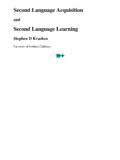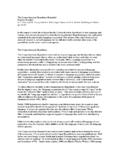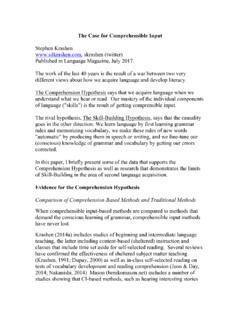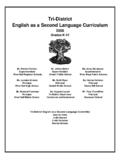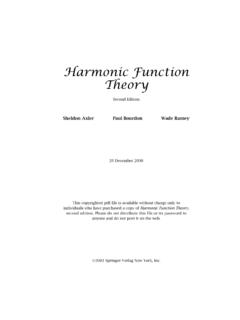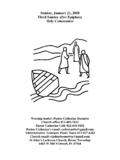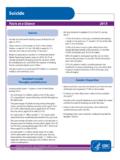Transcription of Principles and Practice - Stephen Krashen
1 Principles and Practice in second Language Acquisition Stephen D Krashen University of Southern California This is the original version of Principles and Practice , as published in 1982, with only minor changes. It is gratifying to point out that many of the predictions made in this book were confirmed by subsequent research, for example, the superiority of comprehensible-input based methods and sheltered subject matter teaching ( Krashen , 2003), the inefficacy of error correction (Truscott, 1996, 1999), and the "power of reading" ( Krashen , 2004). Subsequent research has also, in my opinion, confirmed that in footnote 5, chapter 3, option 3 is the correct one, that we acquire vocabulary best through comprehensible input ( Krashen , 1989;. 2003). I have changed my position on only one issue: At the end of Principles and Practice , I suggest the use of a form of deception - students may think they are acquiring vocabulary or learning subject matter, but unknown to them, they are acquiring because they are getting comprehensible input at the same time.
2 I now think it is very important to make a strong effort to inform students about the process of language acquisition, so they can continue to improve on their own. Krashen , S. (1989) We acquire vocabulary and spelling by reading: Additional evidence for the input hypothesis. Modern Language Journal 73, 440-464. Krashen , S. (2003) Explorations in Language Acquisition and Use: The Taipei Lectures. Portsmouth, NH: Heinemann. Krashen , S. (2004) The Power of Reading. Portsmouth, NH: Heinemann. Truscott, J. (1996). The case against grammar correction in L2 writing classes. Language Learning, 46 (2), 327-69. Truscott, J. (1999). What's wrong with oral grammar correction? The Canadian Modern Language Review, 55(4), 437-56. Introduction to the Internet Edition Copyright 1982 Stephen Krashen All Rights Reserved. This publication may be downloaded and copied without charge for all reasonable, non-commercial educational purposes, provided no alterations in the text are made.
3 First printed edition 1982 by Pergamon Press Inc. Print Edition ISBN 0-08-028628-3. First internet edition July 2009. i Acknowledgments I am indebted to many people who have helped me both directly and indirectly. I can only mention a few of them here. Earl Stevick and Robin Scarcella kindly provided me with detailed comments on nearly every aspect of the manuscript. I have also received a great deal of useful feedback from John Schumann, John Oller, Adrian Palmer, Tracy Terrell, Andrew Cohen, Steven Sternfeld, and Batyia Elbaum. I am sure this book would be much stronger if I had followed all their advice. The task of writing this volume was made much easier by the support and understanding of my family, my wife Eula, my children Deborah and Daniel, and my parents Leo and Julia Krashen . I would also like to thank my colleagues in the Linguistics Department at USC for their intellectual stimulation and encouragement. I.
4 Especially thank Larry Hyman, Edward Finegan, Eugene Briere, Elaine Andersen, Elinor Ochs, Edward Purcell, John Hawkins, and Bernard Comrie. ii Contents I. Introduction: The Relationship of Theory to Practice 1. A. Three Approaches to Method 2. 1. Theory of second language acquisition 2. 2. Applied linguistics research 3. 3. Ideas and intuitions from experience 3. B. Interactions Among Approaches to Practice 4. C. What the Three Approaches Have to Say About Method 6. D. Goals of This Book: to reintroduce teachers to theory and 7. hopefully to gain their confidence again Notes 8. II. second Language Acquisition Theory 9. A. Five Hypotheses About second Language Acquisition 10. 1. The acquisition-learning distinction 10. 2. The natural order hypothesis 12. (a) Transitional forms 14. 3. The Monitor hypothesis 15. (a) Individual variation in Monitor use 18. 4. The input hypothesis 20. (a) Statement of the hypothesis 20. (b) Evidence supporting the hypothesis 22.
5 5. The Affective Filter hypothesis 30. B. The Causative Variable in second Language Acquisition 32. 1. The causative variables 32. 2. Language teaching: does it help? 33. (a) When language teaching helps 34. (b) When language teaching does not help 35. 3. Exposure variables 37. 4. Age 43. 5. Acculturation 45. III. Providing Input for Acquisition 57. A. The Potential of the second Language Classroom 58. B. Limitations of the Classroom 59. C. The Role of Output 60. 1. "Conversation" and language acquisition 61. 2. Output and learning 61. iii Contents cont. D. Characteristics of Optimal Input for Acquisition 62. 1. Optimal input is comprehensible 63. (a) How to aid comprehension 64. 2. Optimal input is interesting and/or relevant 66. 3. Optimal input is not grammatically sequenced 68. (a) The case against the grammatical syllabus 70. 4. Optimal input must be in sufficient quantity 71. (a) Quantity requirements for initial readiness to speak 71.
6 (b) Quantity requirements for higher levels of proficiency 72. E. Other Features that Encourage Acquisition 73. 1. The student should not be put on the defensive 73. 2. Provide tools to help students obtain more input 76. F. "Teaching" Conversational Competence 78. IV. The Role of Grammar, or Putting Grammar in its Place 83. A. Learning Does Not Become Acquisition 83. B. The Place of Grammar 89. 1. Grammar for Monitor use: when the Monitor is used 89. 2. What can be Monitored 92. (a) Incompetent Monitor use 94. (b) Rule learnability 96. (c) Some evidence 98. (d) Consequences of teaching "hard" rules 102. C. The Effects of Learning: Accuracy of Self-correction 104. 1. Factors affecting self-correction accuracy 105. 2. The data 108. D. Other Effects of Conscious Rules 112. E. Presentation of Rules 113. 1. The deductive-inductive issue 113. 2. Sequencing and learning 115. F. Notes on Error Correction 116. G. Grammar as Subject-matter 119.
7 V. Approaches to Language Teaching 125. A. Present-day Teaching Methods 126. 1. Grammar-translation 127. (a) Requirements for optimal input 128. (b) Learning 129. (c) Summary 129. 2. Audio-lingualism 129. (a) Requirements for optimal input 130. (b) Learning 132. (c) Summary 132. 3. Cognitive-code 132. (a) Requirements for optimal input 133. (b) Learning 134. iv Contents cont. (c) Summary 134. 4. The direct method 135. (a) Requirements for optimal input 135. (b) Learning 137. (c) Summary 137. 5. The natural approach 137. (a) Requirements for optimal input 138. (b) Learning 139. (c) Summary 140. 6. Total physical response 140. (a) Requirements for optimal input 140. (b) Learning 142. (c) Summary 142. 7. Suggestopedia 142. (a) Requirements for optimal input 144. (b) Learning 146. (c) Summary 146. B. Applied Linguistics Research 146. 1. Review of method comparison studies 147. (a) American studies of AL, GT, and CC 149. (b) The GUME project 150.
8 2. Some preliminary conclusions to method comparison studies 151. 3. More recent method comparison studies 155. (a) The TPR series 155. (b) Other input methods compared 157. (c) Suggestopedia research 158. C. Alternative to Methods 160. 1. Function of the classroom 160. 2. The second language classroom and requirement #2 161. 3. The alternatives 162. (a) Conversation 163. (b) Pleasure reading 164. (c) Using subject matter for language teaching 167. (d) Evidence for subject matter teaching: the immersion programs 170. (e) Other possibilities in subject matter teaching 171. D. Comments on Achievement Testing 176. 1. Normal considerations in test evaluation and selection 176. 2. Instructional value 177. 3. Language requirements 181. 4. University level ESL 182. E. Some Gaps in Materials 182. 1. The language laboratory 184. 2. A comment on field testing of materials 185. F. Some Problems 186. Bibliography 191. Index 201. v Chapter I.
9 Introduction: The Relationship of Theory to Practice The purpose of this book is to take a new look at an old question: the relationship between second language teaching Practice and what is known about the process of second language acquisition. The usual way to do this is to discuss some research results first, outline a possible theory, and then list some implications. I will, to some extent, follow this plan. A. significant portion of this book is, in fact, devoted to summarizing the current state of second language acquisition theory as I see it. Following this, I will draw some general conclusions about application to methods and materials, and eventually describe what characteristics effective materials should have. Before going through this exercise, however, it is important to state in advance that "theory" and "theoretical research" should not be the only input into deciding on methodology and materials. While my emphasis here is on theory and its implications, it is dangerous to rely only on theory.
10 There are at least three different ways of arriving at answers in methodology and materials, and we must consider all of them. I will devote the remainder of this introduction to a brief description of these three areas, and a discussion of how they interrelate with each other. We will then see what each has to say about method in second and foreign language teaching. My view, for those who like the punch line early, is that all three ways arrive at precisely the same answer. The solution to our problems in language teaching lies not in expensive equipment, exotic methods, sophisticated linguistic analyses, or new laboratories, but in full utilization of what we already have, speakers of the languages using them for real communication. I will also conclude that the best methods might also be the most pleasant, and that, strange as it seems, language acquisition occurs when language is used for what it was designed for, communication.

